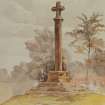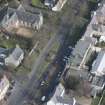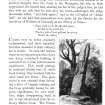Ormiston, Main Street, Market Cross
Market Cross (15th Century)
Site Name Ormiston, Main Street, Market Cross
Classification Market Cross (15th Century)
Alternative Name(s) Mercat Cross
Canmore ID 54699
Site Number NT46NW 1
NGR NT 41418 69277
Datum OSGB36 - NGR
Permalink http://canmore.org.uk/site/54699
- Council East Lothian
- Parish Ormiston
- Former Region Lothian
- Former District East Lothian
- Former County East Lothian
NT46NW 1 41418 69277
(NT 41418 69277) Cross (NR)
OS 6" map, (1970).
Ormiston market cross is a fine 15th century cross. Its square shaft, which is surmounted by a Latin cross, bears a sculptured shield of arms, the device on which is now defaced. It stands on a modern base.
V G Childe and W D Simpson 1954; J W Small 1900.
No change to previous information.
Visited by OS(BS) 21 October 1975.
This 15th century cross may have been connected with a chapel that stood athwart the present High Street, and made over for a new role when the village of Ormiston was built by John Cockburn - about 1735. (cf NT 46 NW(M) 5.)
C McWilliam 1978.
Field Visit (4 October 1915)
In the centre of the main street of Ormiston village is a fine freestanding 15th century cross, which is set on three modern steps within a railed enclosure. The old base is octagonal on plan, but the shaft, a monolith, is square in section, with arrises chamfered and stopped beneath a moulded necking. On the western face of the shaft is a shield in relief. Above the necking is an equal limbed cross-head with roll-and hollow mouldings.
RCAHMS 1924, visited 4 October 1915.
Publication Account (1985)
The mining settlement at Ormiston dates from 1903 when John Clark founded the Orrniston Coal Company. Previously the settlement, set on higher ground a little back from the north bank of the Tyne Water, was essentially rural; and the old part of the village owes much of its character to a former landowner, John Cockburn.
Cockburn was a member of the last Scots Parliament; he subsequently sat in the English Parliament from 1707-41, and during his time in the south familiarised himself with new agricultural practices. In 1736 he founded an agricultural society at Ormiston which met monthly in the village inn to discuss agricultural practices. He sent the sons of his tenants to England to learn new methods; he also founded a brewery and distillery to provide a market for local barley, and laid out a bleach field to support a linen industry, bringing skilled flax workers from Ireland and Holland. A laxspinning school followed. The enterprise was insufficiently profitable at the time, however, and in 1747 he was obliged to sell the village to the Earl of Hopetoun (see no. 30).
Cockburn's principal architectural legacy is his estate village, begun c.1736, a little to the east of the older mill-to un. The wide, tree-lined High Street, 'closed' at both ends by 900 turns in the road, was to be a market centre; the new housing accommodated local craftsmen and the cottage textile workers. He provided the building materials himself, and expected high standards: "I can give my consent to no houses being built in the Main Street of the town but what are two storeys high".
The fine mercat cross stands in the middle of the High Street It dates to the 15th century, a rare survival of a truly cruciform, pre-Reformation 'cross" It may have been associated with a chapel standing across the present street, or it may have come from elsewhere, revitalised as a focus to the new village. The old base is octagonal, set above modem steps. The square-sectioned shaft carries a shield on its western side; the cross-head stands above the moulded 'neck'.
Information from 'Exploring Scotland's Heritage: Lothian and Borders', (1985).












































































